Rediscovering Dolly
Grace Remains at Catfish Farm June 21, 2015
June 22, 2015Grace Finds Another Catfish Farm June 27, 2015
June 29, 2015
We mark wildlife in order to identify individuals during future encounters. For some individuals this allows us to determine where they go, how long they live, where they breed and how many young they produce over a lifetime. Releasing a banded bird into the wild is often coupled with a sense of possibility and wonder. We wonder if we will ever hear about this bird again. Will someone, somewhere identify the bird and provide a report of the encounter? In a similar way, when we encounter a marked bird we wonder when and where it was marked and by whom. For some, the story that emerges is unexpectedly rich.
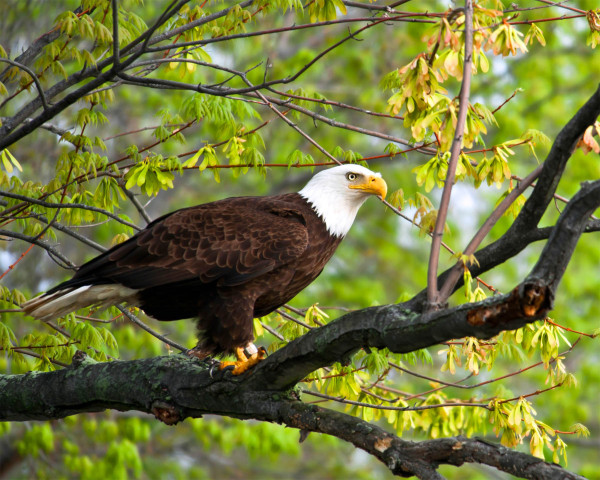
A beautiful photo of Dolly on her breeding territory along the James River. Photo by Marlene Frazier.
On 26 April 2005, an eaglet was hatched in the Birmingham Zoo by two non-releasable adults given the names Camilla and Gonzo. Camilla was brought to the zoo in 1985 after being shot in Florida. Gonzo was also brought to the zoo in 1985 after he suffered an injury from fishing gear near Seattle, Washington. The eaglet produced by the pair was raised by the zoo until it was 6 weeks old, then driven by Cindy Pinger (Curator of Birds) on 8 June 2005 to the American Eagle Foundation’s (AEF) Douglas Lake hacking facility near Dandridge, Tennessee. The bird was banded with an aluminum band that bore the unique code 629-43814. Following a national naming contest held by AEF, the eaglet was named Dolly in honor of country music legend and AEF patron Dolly Parton.
“Dolly” the eagle was housed in the hack tower overlooking Douglas Lake until release on 26 July when she was 13 weeks old. Two days before release, Dolly was fitted with a patagial marker on her left wing that read “5C” in orange digits on a white oval over a green background. On this same day, Dolly was fitted with a tail-mounted radio transmitter and weighed. She weighed 9.8 pounds. After dispersal from the hack site, Dolly was not observed again until 7 months later, when she was photographed by David Bean on 29 March 2006 and identified by her patagial marker on Swift Creek Reservoir just 12 miles southwest of Richmond, Virginia. Following this unusual encounter, Dolly was not noticed again for more than 3 years.
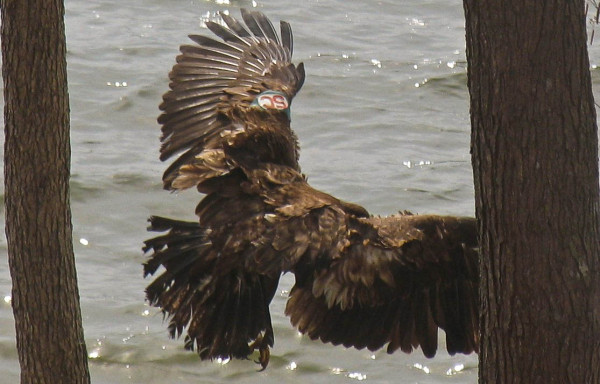
Dolly along the shoreline of Swift Creek Reservoir several months after release on Douglas Lake. She was looking ragged in her second year. Photo by David Bean.
Captain Mike Ostrander from Richmond runs fishing, wildlife viewing, and history boat tours along a stretch of the James River referred to as Jefferson’s Reach. In the fall of 2009, Ostrander observed an eagle pair establishing a territory along the shoreline of Hatcher’s Island. He would later recognize that the female adult was banded and nicknamed her “Bandit.” Dolly had likely lost the patagial marker and transmitter years before. It would take a number of skilled photographers and many photographs to eventually piece together the aluminum band code 629-43814 to identify Dolly and unlock her long story.
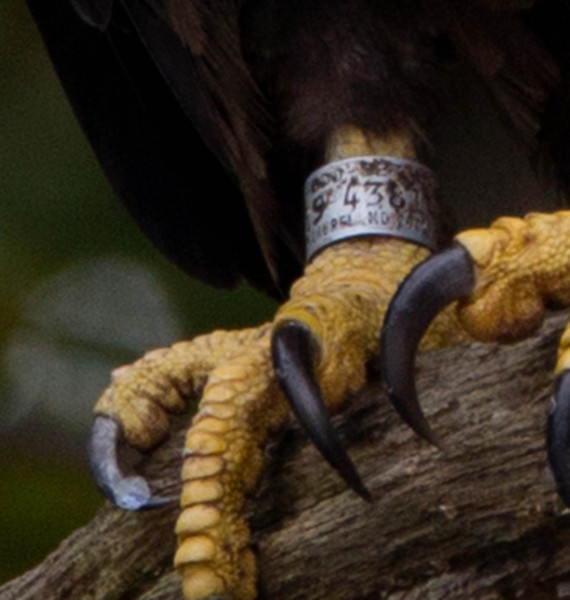
Dolly’s aluminum United States Geological Survey band with partial code. Many photos were used to piece together the full code needed to identify Dolly. Photo by Dave Parish.
Since the fall of 2009, Ostrander has chronicled the details of Dolly’s life along Jefferson’s Reach. He has watched her lose several nests to storms only to rebuild before each breeding season. He has documented at least 3 different mates. For 4 years he has observed Dolly fight to keep her territory against repeated intrusions by competing females, including one bird that persisted along the boundary of the territory for more than a year. He has observed her vacate the territory when injured only to reappear and exert her control unexpectedly. Although Dolly has attempted to breed through the years, she produced no young until 2015.
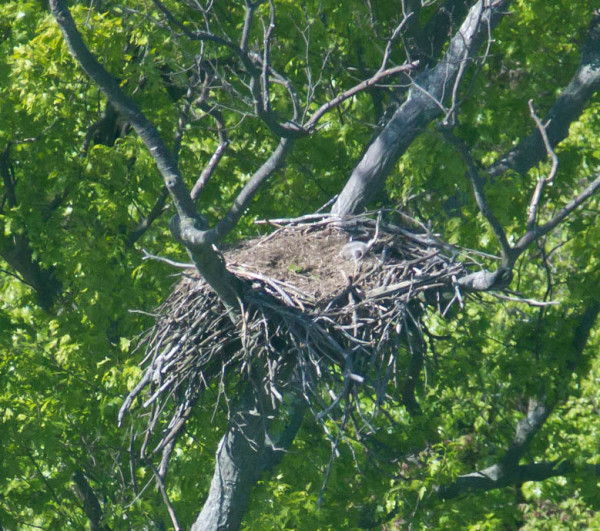
Dolly’s young in the nest (rt side) along Hatcher Island on 29 April 2015. Photo by Bryan Watts.
Dolly, now in her 11th calendar year and 6th breeding season, produced a single young in 2015. During CCB’s first aerial survey of the James on 7 March, we observed Dolly incubating. Later in the spring on 29 April, we observed a single young in the nest that was approximately 2 weeks old. This young was observed in the nest throughout the late spring and successfully fledged in June.
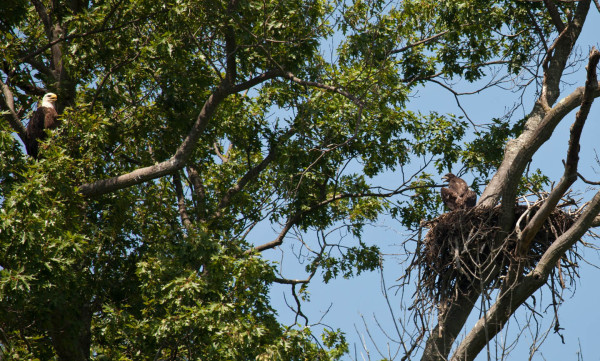
Dolly (lft) watching over young near fledging age in nest along Hatcher Island on 15 June 2015. Photo by Bryan Watts.
From an unlikely beginning in an urban zoo, Dolly has struggled to establish herself and produce young along the James River during a time in the population’s recovery when competitors are many. People along the way who care about bald eagles have contributed to her story, and others have discovered her history through their own curiosity. She has become a fixture along the shoreline of Hatcher Island.
To see Dolly in person and the many eagles of Jefferson’s Reach, take a trip with Captain Mike Ostrander along the James River.
Written by Bryan Watts | bdwatt@wm.edu | (757) 221-2247
June 24, 2015



